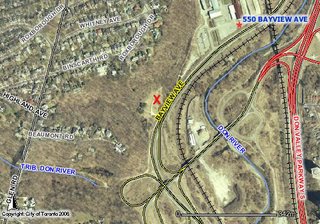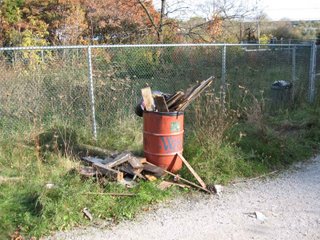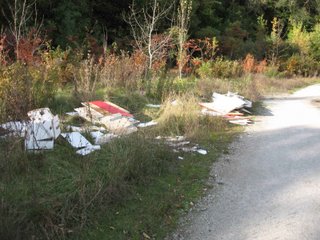
Pottery Road trailhead is crowded with uses and proposals (click to enlarge)
Accommodating a diverse range of uses in natural areas is a complex task, but it is one where the city is making some headway. In the case of the Don Valley it is trying to manage the needs of mountain bikers and other trail users while also seeking to enhance the ecological function of the valley, something that has been severely degraded in the past.
Over the past 15 or so years, mountain bikers have adopted a series of trails through the Crothers' Woods area of the valley. Unfortunately unmanaged use has not always led to good trail design. Case in point: just north of Pottery Road where it meets Bayview Avenue is an access point for these trails. The ground rises sharply and the first trail to be built went straight up the side of a hill. While this was a quick route it became gullied and eroded as rainwater slowly ate away at the ground. There are now two trails because the first one became unusable. Left unattended these trails would eventually become unusable even for hikers.
Fast forward to the present. The city is now working with the
International Mountain Biking Association, or IMBA for short to build a set of trails that will last. Over the past month they have been rerouting the trail so that it runs along the contour of the hill. This type of trail design allows rainwater to flow quickly off the trail and keep it dry.
Volunteers, mostly from the biking community, have been trained on trail construction. Over the past three years they have been slowly fixing the worst spots on the trail. The Pottery Road trailhead is just the latest phase of a long project to improve the trails all the way north to E.T. Seton Park.
Hikers and bikers alike have been hugely appreciative of the efforts by these volunteer trail workers and they should be lauded for their efforts.
The
Task Force to Bring Back the Don has also had its eye on this site for a long time as the location of a proposed wetland. Cudmore Creek cuts through this site and the regular flow of water creates the potential for an expanded ecological function. Most of the wetlands in the Don have been lost due to development and places to create a new one are few and far between.
For one reason or another the wetland project has been delayed. In the interim, the parking lot was created, originally as a construction lot for a hydro project but has since been adopted by the mountain bikers. The wetland proposal is still outstanding and may eventually be built which should enhance the ecological value of this area.
With proper management, human uses can coexist with the natural environment. The city is now looking to develop an overall management plan for this section of the valley. On November 1st, they will hold the first in a series of workshops that will give interested users and the general public a say in how this plan is created. Details of this meeting will be posted here when they become available.

Old trail goes straight down slope which is bad for water drainage.

New trailhead at edge of parking lot

The new contour hugging trail winds through a sumac grove

New trail already in use

A work party continues the trail work. The volunteer in the middle is wielding a Pulaski. It's a pick axe that can also be used for digging. It was adopted for trail work from its origins as a forest fire fighting tool.

This tool is called a Macleod, a versatile tool for cutting, hoeing and compacting.

Using the Macleod for broadcasting dirt away from the work zone.
One of the trail crew has posted a
Flickr slideshow of Sunday's trail work.


























